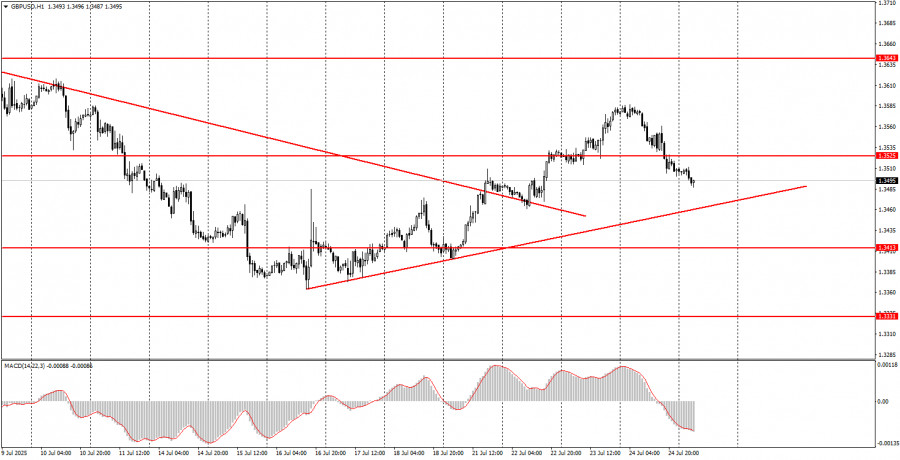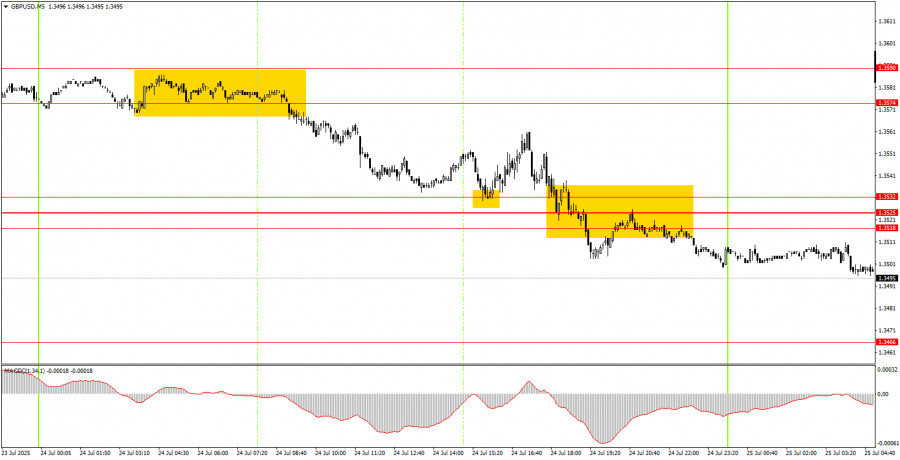Analysis of Thursday's Trades
1H Chart of GBP/USD
On Thursday, the GBP/USD pair exhibited a relatively strong decline, triggered by weak business activity indices in the UK. However, this explanation is only 50% accurate. The business activity indices in the US were no better, yet the dollar strengthened throughout the day. Therefore, we do not believe that the main reason for the pound's decline was the UK indices.
An ascending trendline was drawn based on the last three lows, and above this line, the bulls still hold the upper hand. As before, we see no grounds for a medium-term rise in the US dollar. In our view, the situations involving the trade war and pressure on Jerome Powell are deteriorating day by day, leaving the dollar in a vulnerable position.
Let us recall that any fundamental hypothesis must be confirmed by technical analysis. If the price consolidates today below the ascending trendline, it will indicate a reversal of the short-term trend back to a downward one.
5M Chart of GBP/USD
On the 5-minute timeframe, several trading signals were generated on Thursday. At the start of the European trading session, the price rebounded from the 1.3574–1.3590 area, which provided an opportunity to open short positions. At the beginning of the US session, the 1.3518–1.3532 area was tested, signaling a potential opportunity to open long positions. The buy signal turned out to be false, but it didn't result in a loss since the price managed to move 20 pips in the desired direction.
At the end of the day, the pound broke through the 1.3518–1.3532 area. The signal was formed nearly overnight, but it was still tradable.
Trading Strategy for Friday:
On the hourly timeframe, the GBP/USD pair is showing readiness to form a new local uptrend. The price has consolidated above the descending trendline, indicating expected growth in the coming weeks. The fundamental backdrop continues to work against the US dollar, and the market has not yet priced in many of the negative factors for the greenback.
On Friday, GBP/USD may continue to move upward regardless of the local macroeconomic backdrop. However, to open long positions, it is now necessary to wait for the price to consolidate above the 1.3518–1.3532 area.
On the 5-minute timeframe, the relevant trading levels are: 1.3203–1.3211, 1.3259, 1.3329–1.3331, 1.3413–1.3421, 1.3466, 1.3518–1.3532, 1.3574–1.3590, 1.3643–1.3652, 1.3682, 1.3763, 1.3814–1.3832.
On Friday, the UK retail sales report will be released, and the US durable goods orders report is also due. Both reports are relatively important and could trigger market reactions depending on the results.
Core Trading System Rules:
- Signal Strength: The shorter the time it takes for a signal to form (a rebound or breakout), the stronger the signal.
- False Signals: If two or more trades near a level result in false signals, subsequent signals from that level should be ignored.
- Flat Markets: In flat conditions, pairs may generate many false signals or none at all. It's better to stop trading at the first signs of a flat market.
- Trading Hours: Open trades between the start of the European session and the middle of the US session, then manually close all trades.
- MACD Signals: On the hourly timeframe, trade MACD signals only during periods of good volatility and a clear trend confirmed by trendlines or trend channels.
- Close Levels: If two levels are too close (5–20 pips apart), treat them as a support or resistance zone.
- Stop Loss: Set a Stop Loss to breakeven after the price moves 20 pips in the desired direction.
Key Chart Elements:
Support and Resistance Levels: These are target levels for opening or closing positions and can also serve as points for placing Take Profit orders.
Red Lines: Channels or trendlines indicating the current trend and the preferred direction for trading.
MACD Indicator (14,22,3): A histogram and signal line used as a supplementary source of trading signals.
Important Events and Reports: Found in the economic calendar, these can heavily influence price movements. Exercise caution or exit the market during their release to avoid sharp reversals.
Forex trading beginners should remember that not every trade will be profitable. Developing a clear strategy and practicing proper money management are essential for long-term trading success.













